 W
WArab Woman is a watercolor painting by John Singer Sargent. Completed in either the late 19th or early 20th century, the painting is currently in the collection of the Metropolitan Museum of Art.
 W
WAt Binsey, near Oxford is a watercolour painting by the British Victorian artist George Price Boyce, who was associated with the Pre-Raphaelite art movement.
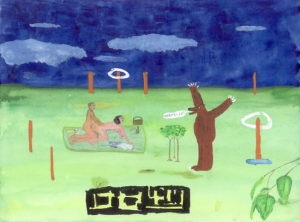 W
WBear Surprise is a watercolor painting by American painter/musician John Lurie, the style of which has been described as primitivist and naïve. The painting depicts a couple having sex in a meadow, with a bear standing in front of them, with fore paws in a distinctive position. There is a speech bubble beside the head of the bear, which reads "Surprise!".
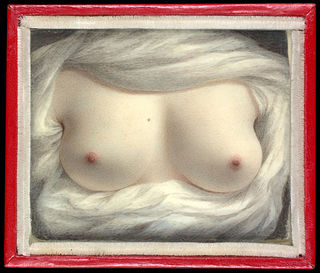 W
WBeauty Revealed is an 1828 self-portrait by the American artist Sarah Goodridge, a watercolor portrait miniature on a piece of ivory. Depicting only the artist's bared breasts surrounded by white cloth, the 6.7-by-8-centimeter painting, originally backed with paper, is now in a modern frame. Goodridge, aged forty when she completed the miniature, depicts breasts that appear imbued with a "balance, paleness, and buoyancy" by the harmony of light, color, and balance. The surrounding cloth draws the viewer to focus on them, leading to the body being "erased".
 W
WBermuda No. 2, The Schooner is an early 20th century drawing by American artist Charles Demuth. Done in watercolor and graphite on paper, the work depicts the ship Danish ship Elsa. The drawing is in the collection of the Metropolitan Museum of Art.
 W
WBlack Stork in a Landscape is an 18th-century watercolor painting of a woolly-necked stork. The painting, which is currently in the collection the Metropolitan Museum of Art, was commissioned by Claude Martin as part of a series of 658 ornithological paintings.
 W
WBoy Cutting Grass with a Sickle is a watercolor painting created in 1881 by Vincent van Gogh. It is owned by the Kröller-Müller Museum.
 W
WChildren Under a Palm is a water colour painting by Winslow Homer. It was featured in the second episode of the BBC TV series Fake or Fortune?
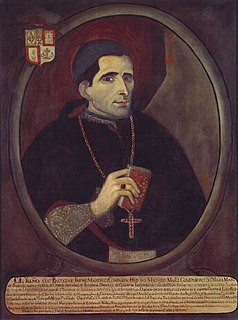 W
WThe Codex Martínez Compañón (c.1782–1785), is a manuscript edited in nine volumes by the bishop of Trujillo, Peru, made by Baltasar Jaime Martínez Compañón, containing 1,411 watercolours and 20 musical scores documenting life in his diocese. This work was sent to Charles IV of Spain, who included it in the Royal Library in 1803. The musical examples in the bishop's text were probably written out by Pedro José Solis, maestro de capilla of Trujillo Cathedral from 1781 to 1823.
 W
WComposition VII is an abstract oil painting executed in 1913 by Wassily Kandinsky, a Russian-born painter. It is in the collection of the Tretyakov Gallery, Moscow. Art historians have concluded that the work is a combination of the themes of Resurrection, Judgment Day, the Flood and the Garden of Eden.
 W
WThe Crucifixion, seen from the Cross is a c. 1890 watercolor painting by the French painter James Tissot. The work is unusual for its portrayal of the site, the women witnesses, and bystanders from the perspective of Jesus on the cross, rather than featuring Him as the center of the work; His figure is nearly not shown.
 W
WDiminutive Folded Linear Series #4 is a painting by Yvonne Pickering Carter. It is in the collection of the Gibbes Museum of Art in Charleston, South Carolina in the United States.
 W
WDrawbridge in Nieuw-Amsterdam is a watercolor created in November 1883 by Vincent van Gogh in Drente, The Netherlands.
 W
WThe Flower Book by Edward Burne-Jones (1833–1898) is a series of 38 round watercolours, each about six inches across, painted from 1882 to 1898. The paintings do not depict flowers; rather, they were inspired by the flowers' names. Burne-Jones called them "a series of illustrations to the Names of Flowers". "Not a single flower itself appears", according to his wife Georgiana. They were painted for his private pleasure, many while he was resting at his summer home in Rottingdean, and were described by his wife as the "most soothing piece of work that he ever did". In 1905 Georgiana, by then a widow, published a limited edition of high-quality colour facsimiles.
 W
WThe Four and Twenty Elders Casting their Crowns before the Divine Throne is a pencil drawing and watercolour on paper by the English poet, painter and printmaker William Blake. Created circa 1803–1805, the drawing has been held in London's Tate gallery since 1949. It is likely a visionary and hallucinatory summary of scenes from Chapters 4 and 5 of the Book of Revelation when the throne of God was presented to the prophet Saint John the Divine.
 W
WThe Great Red Dragon Paintings are a series of watercolour paintings by the English poet and painter William Blake, painted between 1805 and 1810. It was during this period that Blake was commissioned to create over a hundred paintings intended to illustrate books of the Bible. These paintings depict 'The Great Red Dragon' in various scenes from the Book of Revelation.And behold a great red dragon, having seven heads and ten horns, and seven crowns upon his heads. And his tail drew the third part of the stars of heaven, and did cast them to the earth.
 W
WThe Ha'Penny Bridge Dublin is a watercolour, of the Ha'Penny Bridge, by Samuel Frederick Brocas, from 1818.
 W
WHermia and Lysander is a watercolor painting created in 1870 by British illustrator and miniature portrait painter John Simmons. Based on a scene from Act II, scene II of William Shakespeare's comedy play A Midsummer Night's Dream, it measures 89 by 74 centimetres.
 W
WWilliam Blake drew and painted illustrations for John Milton's nativity ode On the Morning of Christ's Nativity between 1803 and 1815. A total of 16 illustrations are extant: two sets of six watercolours each, and an additional four drawings in pencil.
 W
WWilliam Blake's Illustrations of the Book of Job primarily refers to a series of twenty-two engraved prints by Blake illustrating the biblical Book of Job. It also refers to two earlier sets of watercolours by Blake on the same subject. The engraved Illustrations are considered to be Blake's greatest masterpieces in the medium of engraving, and were also a rare commercial and critical success for Blake.
 W
WThe Impey Album was a collection of paintings commissioned by Elijah Impey (1732–1809) and his wife Mary, née Reade (1749–1818), of the animals in their menagerie in Calcutta, India, where Elijah was chief justice of the Supreme Court.
 W
WJuly Reflections is a watercolor on seamed paper by Martha Burchfield that she made in 1972 in Buffalo, New York based on a pencil sketch.
 W
WL.S.D.F. #50 is a painting by Yvonne Pickering Carter. It is in the collection of the North Carolina Museum of Art in Raleigh, North Carolina in the United States.
 W
WLandscape from Tsarigrad is a watercolor by Vladimir Dimitrov, from 1926.
 W
WLove's Messenger is an 1885 watercolor by Marie Spartali Stillman in which a dove has just carried a love letter to a woman standing in front of an open window. She wears a red rose, and has just put down her embroidery of a blind-folded Cupid.
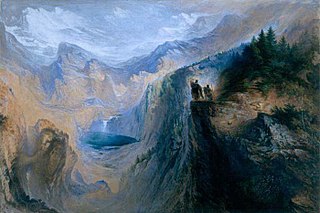 W
WManfred on the Jungfrau is an 1837 watercolour painting by the English artist John Martin, now in Birmingham Museum and Art Gallery. The subject of the painting comes from Lord Byron's poem Manfred, specifically Act I scene II. It was painted by a number of 19th-century artists.
 W
WThe Meeting on the Turret Stairs is an 1864 watercolor painting by Frederic William Burton. The painting is in the National Gallery of Ireland.
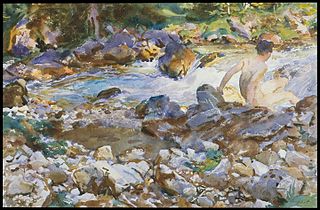 W
WMountain Stream is an early 20th century watercolor painting by the American artist John Singer Sargent. Done in watercolor and graphite pencil on wove paper, the work depicts a nude figure by a dazzling mountain stream. Sargent's work was donated to the Metropolitan Museum of Art, where it remains, as part of the bequest of Joseph Pulitzer in 1915.
 W
WOur Daily Bread is a watercolor painting executed c.1886 by the Swedish artist Anders Zorn which is in the collection of the Nationalmuseum in Stockholm, Sweden.
 W
WThe U.S. Department of Agriculture's Pomological Watercolor Collection is an archive of some 7,500 botanical watercolors created for the USDA between the years 1886 and 1942 by around five dozen artists. Housed by the United States National Agricultural Library, it is a unique resource documenting existing fruit and nut cultivars, new introductions, and specimens discovered by USDA's plant explorers, representing 38 plant families in all. It has been called "one of the world's most unusual holdings of late 19th and early 20th century American botanical illustrations".
 W
WGeorgia O'Keeffe made a set of paintings of Palo Duro Canyon while working as a department head and art instructor at West Texas State Normal College. The vibrant paintings reflect her development as an Abstract Expressionist, influenced by Arthur Wesley Dow.
 W
WThe Paying-out Machinery in the Stern of the Great Eastern is a watercolor by British artist Robert Charles Dudley. The work is available in the collection of the Metropolitan Museum of Art.
 W
WPity is a colour print on paper, finished in ink and watercolour, by the English artist and poet William Blake, one of the group known as the "Large Colour Prints". Along with his other works of this period, it was influenced by the Bible, Milton, and Shakespeare. The work is unusual, as it is a literal illustration of a double simile from Macbeth, found in the lines:And pity, like a naked new-born babe, Striding the blast, or heaven's cherubim, hors'd Upon the sightless couriers of the air. - Macbeth (1.7.21–23)
 W
WPornocrates, Pornokratès, La dame au cochon, or The Lady with the Pig is a work by the Belgian artist Félicien Rops, created in 1878. It is part of the collection of the Musée provincial Félicien Rops in Namur, Belgium.
 W
WPortrait of a young man or The young man is a mid-nineteenth century watercolor painting by Mirza Gadim Iravani, an Azerbaijani painter. The painting is stored in the National Art Museum of Azerbaijan in Baku. The ornamentality is thoroughly harmonized with volumetric and plastic modeling of the shape as in other paintings by Iravani. Although the portrait was closely related to traditions of the medieval oriental miniature, the artist's interest in the external appearance of a man portrayed on a three-dimensional space of a concrete interior illustrate a crucial development in the Azerbaijani visual arts of the time.
 W
WThe Portrait of Saint Bartley Harris is a late-nineteenth-century watercolor portrait by Maria Howard Weeden, an artist from Huntsville, Alabama.
 W
WThe Raven is a series of 28 watercolor paintings made by Nabil Kanso in 1995. The subjects of the works in the series are based on the 1845 poem "The Raven" by Edgar Allan Poe.
 W
WGeorgia O'Keeffe made a number of Red Canna paintings of the canna lily plant, first in watercolor, such as a red canna flower bouquet painted in 1915, but primarily abstract paintings of close-up images in oil. O'Keeffe said that she made the paintings to reflect the way she herself saw flowers, although others have called her depictions erotic, and compared them to female genitalia. O'Keeffe said they had misconstrued her intentions for doing her flower paintings: "Well – I made you take time to look at what I saw and when you took time to really notice my flower you hung all your own associations with flowers on my flower and you write about my flower as if I think and see what you think and see of the flower – and I don't."
 W
WIn 1842, British artist J. M. W. Turner painted three watercolours of the Rigi, a mountain in the Alps in Central Switzerland, which he had visited the previous summer. Widely regarded as some of his finest works, the watercolours capture the transitory effects of light and atmospheric conditions at the Rigi. According to John Ruskin, "Turner had never made any drawings [watercolours] like these before, and never made any like them again ... He is not showing his hand in these, but his heart."
 W
WSaint Joseph Seeks a Lodging at Bethlehem is an opaque watercolor painting over graphite by James Tissot. The painting was created between 1886-1894, near the end of James Tissot's Career. This style of painting is also known as Gouache.
 W
WSalem is a 1908 painting by the English painter Sydney Curnow Vosper, depicting a scene within Capel Salem, a Baptist Chapel in Pentre Gwynfryn, Gwynedd, Wales. It is noteworthy as a depiction of Welsh piety, the traditional Welsh national costume, and for a contentious belief that the devil is depicted within it. Mass reproductions throughout the early and mid 20th century ensured the image became famous throughout Britain.
 W
WSelf-Portrait with a Blue Sketchbook is a 1907 watercolour painting by Léon Spilliaert. It is part of a series of ten self-portraits produced by the artist between 1907 and 1908. It has been in the collection of the Royal Museum of Fine Arts, Antwerp since 1950
 W
WSommarnöje is a watercolour painting by the Swedish painter Anders Zorn, made in 1886 at Dalarö near Stockholm. It was sold in 2010 for SEK 26 million, a record for a Swedish painting.
 W
WSplendid Mountain Watercolours or Splendid Mountain Sketchbook is a collection of sketches and watercolors by John Singer Sargent (1856–1925), executed when he was fourteen years old, and on a summer excursion to Switzerland’s Bernese Alps in the Berner Oberland in 1870. The sketchbook contains 60 leaves, including 14 watercolors and 47 crayon or graphite studies of the mountains, landscapes and people he encountered while traveling with his family.
 W
WThe Star of Bethlehem is a painting in watercolour by Sir Edward Burne-Jones depicting the Adoration of the Magi with an angel holding the star of Bethlehem. It was commissioned by the Corporation of the City of Birmingham for its new Museum and Art Gallery in 1887, two years after Burne-Jones was elected Honorary President of the Royal Birmingham Society of Artists. At 101 1/8 x 152 inches, The Star of Bethlehem was the largest watercolour of the 19th century. It was completed in 1890 and was first exhibited in 1891.
 W
WStay Up Late is a 1992 erotic furry watercolor painting by Brian Swords. It depicts two anthropomorphic rats embracing. The painting gained prominence when John Oliver offered to buy the painting in the 29 March 2020 episode of Last Week Tonight with John Oliver.
 W
WA Syce (Groom) Holding Two Carriage Horses is a watercolor painting by Shaikh Muhammad Amir of Karraya. The painting was finished circa 1845 in Calcutta, India. It is now in the Metropolitan Museum of Art in New York. It is an example of Company painting by Indian artists for the British in India.
 W
WTommies Bathing is a 1918 watercolor painting by John Singer Sargent. It is in the collection of the Metropolitan Museum of Art.
 W
WList of drawings by Vincent van Gogh is an incomplete collection of drawings by the Dutch artist Vincent van Gogh (1853–1890) that form an important part of his complete body of work. The listing is ordered by year and then by catalogue number. While more accurate dating of Van Gogh's work is often difficult. As a general rule the numbering from Jan Hulsker's catalogue is more precise chronologically
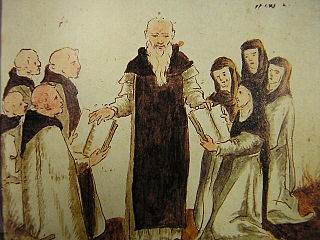 W
WThe Vaticinia Michaelis Nostradami de Futuri Christi Vicarii ad Cesarem Filium D. I. A. Interprete, or Vaticinia Nostradami for short, is a collection of eighty watercolor images compiled as an illustrated codex. A version of the well-known Vaticinia de Summis Pontificibus of the 13th–14th century, it was discovered in 1994 by the Italian journalists Enza Massa and Roberto Pinotti in the Biblioteca Nazionale Centrale di Roma in Rome, Italy. The document can be found in the library under the title Fondo Vittorio Emanuele 307.
 W
WA Vision of the Last Judgement is a painting by William Blake that was designed in 1808 before becoming a lost artwork. The painting was to be shown in an 1810 exhibition with a detailed analysis added to a second edition of his Descriptive Catalogue. This plan was dropped after the exhibition was cancelled, and the painting disappeared. Blake's notes for the Descriptive Catalogue describe various aspects of the work in a detailed manner, which allow the aspects of the painting to be known. Additionally, earlier designs that reveal similar Blake depiction of the Last Judgement have survived, and these date back to an 1805 precursor design created for Robert Blair's The Grave. In addition to Blake's notes on the painting, a letter written to Ozias Humphrey provides a description of the various images within an earlier design of the Last Judgement.
 W
WWater Series #30 is a painting by Yvonne Pickering Carter. It is in the collection of the Pennsylvania Academy of the Fine Arts in Philadelphia, Pennsylvania in the United States.
 W
WWindows in the West is a 1993 watercolour painting by the Scottish artist Avril Paton. The painting was bought by the city of Glasgow for the Glasgow Gallery of Modern Art, and is currently on display at the Kelvingrove Art Gallery and Museum.
 W
WThe Wood of the Self-Murderers: The Harpies and the Suicides is a pencil, ink and watercolour on paper artwork by the English poet, painter and printmaker William Blake (1757–1827). The work was completed between 1824 and 1827 and illustrates a passage from the Inferno of the Divine Comedy by Dante Alighieri (1265–1321). The work is part of a series which was to be the last set of watercolours Blake worked on before his death in August 1827. It is held in the Tate Gallery, London.